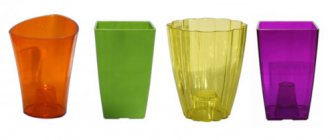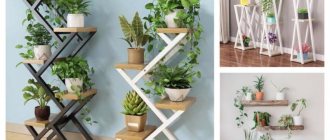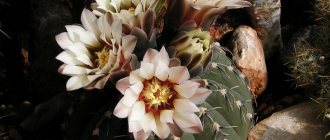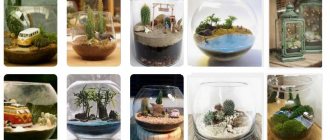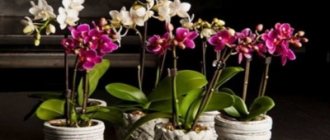How to choose the right container?
How the cactus will grow, and whether it will grow at all, directly depends on the qualities of the pot: its size, the presence of drainage holes, and the material it is made of. And so that you don’t have to replant the poor thing for a long time and painfully, it is better to immediately approach the choice of a pot with all seriousness.
Dimensions
The first factor is the size of the pot. The development of the plant’s root system, and, as a consequence, the plant itself, will depend on the size.
The dimensions of the pot should be selected in proportion to the cactus and its roots:
If the roots of the cactus are tap or turnip-like, you should purchase a deep pot. In a pot that is not deep enough, the root will hit the ground and begin to rot.- For cacti with a fibrous root system, wide pots are suitable. The diameter should correspond to the size of the root.
The cactus is replanted once every 2-3 years, while increasing the size of the pot by 1-2 cm; it should always be larger than the roots by this amount. However, it is worth noting that if the growth and flowering of the succulent does not stop, then you can postpone the “moving”. What happens if you neglect the size of the pot?
- Too big. If you plant a small cactus in a pot that is too large, then after a while this will lead to its death due to excessive moisture and acidification of the soil (what soil is suitable for cacti?).
Is it possible to get a smaller pot? You can increase the level of expanded clay at the bottom, thereby reducing the soil level so that only the roots and root neck of the cactus are in the ground. - Too small. The roots of the cactus will eventually rest against the walls of the pot, which, without timely replanting, will lead to rotting of the roots and death of the plant.
Which material is better to choose?
The second factor will be the material. The two most common materials for making containers are clay and plastic. Pottery is considered traditional for growing any plant. The manufacturing material is popular due to its beneficial properties, but it also has disadvantages.
The obvious advantages include:
- Porosity.
- Resistance that allows higher species to be grown in them.
- Ability to retain shape better than plastic counterparts.
- The ability to quickly evaporate moisture.
But on the other hand:
- Heavy weight.
- Rapid evaporation leads to accelerated formation of a salt layer (white coating) on the inside of the container, which ultimately causes alkalization of the soil.
- The same evaporation forces you to water the plant more and more often (read about how to properly water a cactus here).
Plastic, called “plastic” in stores, appeared not so long ago, but has already occupied its niche. There are disposable and reusable plastic pots , depending on the price, and have the following properties.
Positive:
- Low price compared to clay.
- Light weight.
- Ease of storage and transportation.
Flaws:
- Plastic walls do not allow moisture to pass through.
Therefore, to avoid root rotting, watering should be limited. Important! For a cactus in a plastic container, you should spend no more than a third of the water that is spent on watering it in a clay container. - From the first disadvantage follows the second: the earth will dry unevenly, so the surface may be dry when there is still moisture at depth.
So what should you choose?
- For small plants, plastic is much better than clay. Due to the small size of the pot, and, consequently, the soil in it, evaporation will occur at a sufficient rate, and less frequent watering will not harm the roots.
- For larger succulents, clay is a better option. Due to its stability, a clay pot will withstand the weight of the earth and a large plant without tipping over.
Form
The third factor is form. If the dimensions depend on the type of succulent chosen, then the shape of the pot is only an aesthetic preference of the gardener. It is worth noting that square pots will take up less space , but this is the only thing that can influence the choice.
Is it possible to plant in a container without holes?
The fourth factor will be the holes in the bottom of the pot. Their presence is no less important than its size, because the holes do not allow liquid to stagnate, thereby saving the roots from rotting. A cactus cannot exist in a pot without them or with a small amount of them.
What should you pay attention to?
Florist shops, souvenir shops and household goods departments often offer a wide range of containers for indoor plants. You can choose them according to criteria such as price, decorative qualities (color, shape, finish), product dimensions, and type of material.
206349833-gorki.png
As a general rule, the depth of the pot should be approximately twice the height of the plant. The width or diameter can be selected based on the size of the above-ground part of the cactus/succulent, or taking into account the space required for a composition of several objects.
e6a4bc087a3564620d05533de14652548c0dn6.jpg
As for the types of raw materials, flower pots are usually made from:
- plastic;
- clay;
- gypsum;
- concrete;
- glass
All of the above options are quite suitable for desert “thorns”; moreover, they don’t even need to have a drainage hole in the vessel, just in this case you will need to be more careful in watering and fertilizing, and lay a good layer of stones on the bottom.
pots-plants-cactus-succulent.jpg
Photo
The photo below shows what pots are needed for growing cacti.
What size pot should I plant a cactus in for active growth?
The size of the pot for cacti is of priority importance, therefore, after purchasing new cacti, a cactus grower most often needs to immediately transplant the plants from small pots into larger containers that are suitable for their further cultivation. There is no clear answer to the question of what size a pot should be. Each gardener decides which pot to plant the cactus individually, depending on the possibilities of choosing a pot.
The new pot should provide the plant with the opportunity for normal active growth and development for one to two years, and the earthen ball in it should be completely penetrated by roots after a certain time.
On the other hand, it is also wrong to plant a small plant in a very large pot. Otherwise, in the substrate, where the roots do not entwine the entire earthen ball for a long time, unpleasant rotting processes may begin. Therefore, it is better to plant several very small plants together in a larger pot or bowl.
Prices in Moscow and St. Petersburg
Question price? Depends on the material, size, appearance and place of purchase:
| Pot | Price in St. Petersburg | Price in Moscow |
| "Mellange" gray 1.5 l 150 mm, ceramic | 202 rubles/piece | 198 rubles/piece |
| “Patterns” white, 14.4 l 288 mm, ceramics | 942 rubles/piece | 942 rubles/piece |
| “Jardine” terracotta 1.6 l 150 mm, plastic | 38 rubles/piece | 38 rubles/piece |
| "Jardine" gray, 13 l 350 mm, plastic | 281 rub/piece | 281 rub/piece |
Cacti in bowls
I think I won’t be wrong if I say that probably every second person in the world grew cacti. Quite often, growing cacti in small clay pots is accompanied by a constant limescale deposit. Plaque forms when water evaporates during irrigation, especially if the water is hard. There is a gradual alkalization of the substrate, which leads to the death of the cactus root system, since the plant prefers slightly alkaline mixtures.
But we strive to ensure that our indoor plants, including cacti, are healthy and grow safely. It is not without reason that cacti lovers tend to grow cacti in bowls, thus giving the plants more free space to live.
Attractive landscape compositions of well-growing cacti in low containers or bowls for amateurs please the eye. But avid cactus growers, on the contrary, create greenhouses and greenhouses, where they create all the necessary conditions for the growth of cacti and grow them in separate pots.
Which bowl to choose
You should determine the location of the bowl with cacti in the interior. The life of all plants depends to a large extent on lighting, and if you place your flower arrangement in a bowl in the middle of the table in the back of the room, then the cacti will not feel well, they will definitely be dark. To place cacti on window sills, preference should be given to dishes in the form of balcony boxes.
This advice is based on the fact that plastic bowls are usually sold together with trays, where excess moisture usually drains during watering.
How to do it yourself?
There is no desire to buy a ready-made pot, but you have an unnecessary plastic bottle on hand? You can easily make a pot for a small cactus from it.
You will need:
- Empty 2 liter bottle.
- Soldering iron.
- A can of spray paint or any other item to decorate our “vase”.
- Scissors.
Procedure:
- We cut the bottle into two parts, focusing on the size of the succulent. We use the bottom part.
- We heat up the soldering iron and use its tip to burn several small holes at the bottom of the bottle. These will be the drainage holes.
- We cover the surface with spray paint or decorate it in any other way.
Florarium for cacti and succulents
A florarium is a kind of analogue of an aquarium, designed for growing drought-resistant and light-loving species. Cacti look especially impressive in such vessels, since not only their ground parts remain visible, but also layers of sand, stones and other natural elements that recreate the exotic atmosphere of the desert.
701449.jpg
Most often, hemispherical or diamond-shaped glass containers are actually used as florariums. However, no one forbids replacing them with ordinary transparent salad bowls, teapots, vases and other kitchen and decorative utensils, pouring tinted sand inside and planting miniature prickly plants along with a variety of mosses and succulents.
12891822.jpg
original.jpg
Is it permissible to use it after another plant?
Is it possible to use used pots? You can, but you must follow these rules:
- It doesn't have to be a plastic disposable potty.
- It must be washed well, all remnants of the previous plant must be removed.
- If a diseased plant grew in it, the pot should be filled with a bleach solution (10%) and left for 60 minutes.
- The dimensions must match the succulent being planted.
Many novice flower growers have questions: how to properly care for a cactus, when and how to prune, fertilize and replant it, and how to choose the best place to place it? On the pages of our website you will find answers to all your questions.
The cactus is demanding of its home; it simply will not live in a bad one. But if you try to please him, or better yet, be able to do this, he will delight everyone with his flowering for many years.
Features of cactus pots
For a comfortable existence, cacti require warmth, dryness and constant access of air to the roots. This is mainly influenced by the microclimate in the room, and the material of the container can only enhance or weaken the impact of various factors. For example, through micropores in the walls of clay products, excess moisture evaporates and natural ventilation occurs, which has a beneficial effect on the plant. At the same time, glass and plastic create an impenetrable barrier for liquid, keeping it inside the earthen clod.
gorshki-dlya-kaktusov.jpg
Ceramics and metal quickly heat up in the sun, and then slowly release heat - due to this, the succulent does not suffer as much from sudden temperature changes on cool evenings. Concrete, gypsum, and wooden containers are relatively neutral. They are completely safe from an environmental point of view, in addition, they go well with all types of indoor flowers.
420377bd7dfd42b85c6a8436920fc7e201998l.jpg
How does prickly pear cactus reproduce?
The culture is propagated in two ways: seeds and cuttings.
Cactus is propagated by seeds less frequently. They, located in a hard shell, are removed by sawing it. Or the shell is treated with sandpaper or a file so that the seeds can germinate. To ensure sterility, they are kept for 10 minutes in a solution of potassium permanganate, and the soil, consisting of leaf soil, coarse sand and crushed charcoal, is evaporated in the oven.
The pot is covered with film and placed at a temperature of 20 degrees. Periodically, the film is opened for spraying and removal of condensation. When the seeds sprout, they are planted in small containers and kept in good light, but without direct sun. For 2 years, the sprouts are grown under these conditions, then transplanted into soil for adult prickly pears.
Prickly pear seeds
The vegetation method is used at any time of the year in warm room temperature conditions. The cutting is cut off from the shoot and dried in a vertical position for 1-3 days until a film forms on the cut. Then they are planted in soil that has been previously calcined in the oven, deepening it by 3 cm. A substrate for cacti, sand, is suitable for this. The cutting is placed under the film at a room temperature of 20-22 degrees, the soil is regularly ventilated and moistened, slightly opening the film. After rooting, transplant into soil for an adult plant.
The cutting may not show signs of growth for a long time, but with the onset of spring and over the summer it quickly transforms into a bush. The cactus will bloom next year.
Propagation of prickly pear by cuttings
Transforming ordinary pots and flowerpots
If you have a lot of different old flower pots at home, but you are tired of their unprepossessing appearance, you can transform them using improvised means.
Example of decorating flower pots
Do-it-yourself ceramic pots for succulents can be tightly tied with twine, which will give them an unusual, interesting look. Acrylic paints and stencils will help you create original ornaments and designs on the walls of the vessel. It can also be decorated using a variety of beads and decorative stones. Having sculpting skills, you can decorate a vessel using polymer clay, creating unique landscapes and other images.
Glass pots for succulents, which are popular when growing a flower terrarium, can be made by choosing the appropriate kitchenware yourself. You can make a glass pot for succulents with your own hands from a large cognac glass or use glass bowls for these purposes. They can be decorated in different ways, the main thing is to maintain the general style of the composition and the room in which it is located.
Glass jars also work great as small planters for succulents.
The use of textiles is also important for decoration. With your crocheting skills, you can make unusual flowerpots for your favorite flowers. Here the imagination is limitless - from delicate lace to cute and funny themed figures.
Draping vessels with burlap also creates incredibly beautiful images in the Provençal style. Ribbons, beads and seed beads are also used for decoration. There are no clear rules in decorating pots; the main thing is to follow the general style and not to overdo it with the decor. It is also important not to compromise the functionality and comfort of the vessel. After all, the main thing is that the flower grows comfortably in this container.
Photo of a decorative pot with a composition of succulents
We have described just a few ideas on how to make a pot for succulents with your own hands. But with some imagination and a little creativity, you can make it from almost any material at hand. Don't be afraid to experiment, and the implementation of the most unexpected ideas can become a delightful interior decoration.
Choosing a place for a cactus
Often, inexperienced owners place a pot of cactus near the computer or on a bookshelf, believing that this picky plant can grow in the shade. Over time, the flowerpot turns yellow and the needles begin to fall off. In order to avoid these unpleasant consequences, you need to figure out what type of cactus your pet belongs to.
Cactus is a picky plant that can decorate any interior.
South window sills
Desert cacti are sun lovers. This species is able to survive in the most extreme conditions due to its thickened root system. The ribbed surface ensures minimal evaporation of moisture, which explains the pickiness in terms of watering.
Most house cacti love sunlight, but direct rays should be avoided. This plant can be kept in open areas for no more than 6 hours. It is advisable to hang a tulle or curtain on the window, which will protect the prickly pet. Leaf cacti and epiphytes cannot tolerate the scorching sun at all. This type of cactus should be in the sun for no more than 4 hours.
East and north windows
The north or east side is the most optimal for the growth of cacti. Sometimes on the south side the plant gets burned under the influence of direct sunlight, so you need to create light partial shade. It all depends on the climate: those who live in a country with a hot climate choose the north or east side, and those who live in cold countries choose the south.
Important! Only 70% of these plants can tolerate direct sun exposure. Even this category gets burned when exposed to the sun for a long time: the top layer turns red or turns black. Burns do not harm the plant, but it is still advisable to choose a northern window sill and sometimes take the cactus to the balcony.
Preparing to transplant cacti
The best time to transplant cacti is the end of March, April, beginning of May, i.e. when plants are just starting to grow. But if necessary, you can replant cacti throughout the growing season. When transplanting healthy cacti with a noticeably grown root system, the new pot should be slightly larger than the old one. The old pot should fit freely into the new one. If rotten or dead roots are found during transplantation, they must be carefully removed with nail scissors. In this case, the pot is taken a little smaller than the old one, and more sand and pieces of charcoal are added to the soil. Slowly growing cacti, which have not grown much of the root system since the last transplant, can be planted in the same pot, just replace the soil with fresh one.
Before replanting, it is better to disinfect both the pots and the soil. The pots can be doused with boiling water, and the soil mixture can be kept in the oven for about half an hour. Before transplanting, cacti are not watered for 2-3 days, because part of the wet soil will inevitably remain on the roots, and if the roots are injured, cracked, or broken, moisture quickly leads to rotting. The soil mixture for planting should not be cold, dry, but may be slightly damp, but in no case soggy. I’ll explain what slightly moist soil means - this is exactly the moisture content of soil purchased in a store when the package is opened. It does not dry into dust, but when clenched in a fist, it clumps slightly, but quickly disintegrates.
The stem of a cactus can be held with tweezers
If you don't have tweezers, use a strip of paper
A healthy cactus has such a powerful root system that it is not so easy to remove it from the pot.
